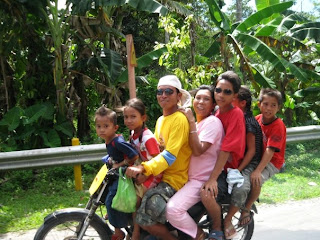The capital city of the Philippines is Manila. It is part of a large entity called Metro Manila. The easiest way of putting it is this: Manila is the beginning, Metro Manila is the result.
Metro Manila has 16 cities and 1 municipality. It has more than 10 million people living in it and I’m one of them. I live in a city called Mandaluyong where it’s highly accessible to shopping malls and Makati City, the country’s central business district.
With such a large land area, the question comes up:
What do I ride to get around Metro Manila?
There are private and public vehicles. There are metered taxis but it really depends on one’s budget to ride them. I have no car so I’m taking public transport. There’s something to remember about public vehicles. Words such as “ordinary” and “special” will come in handy as I mention a common transportation found within the islands—The Tricycle.
It’s called the tricycle for obvious reasons. It has a sidecar that can comfortably seat two people and two passengers behind the driver. However, there are times when passenger capacity is flexible and it can accommodate eight people. Or more.
How to be special
If you’re willing to share your tricycle with others, the fare is lower. That’s “ordinary” but if you want to go solo, you’ll pay a much higher fare and be “special”. That’s one of the basic rules in Philippine public transportation.
Here’s another way of putting it:
This bus is “ordinary” because it’s not air-conditioned.
This bus is “special” because it has air-conditioning and probably a television inside.
The price difference isn’t too huge but it gives an option to a lot of people who’d like to stretch their budget.
Our train system
We also have train systems such as the Light Rail Transit 1 and 2 (LRT), and the Metro Rail Transit (MRT), which makes traveling much more convenient.
This was taken while waiting for the next train in the LRT 2, which was completed almost seven years ago. This LRT train station is located in Quezon City, named after the Philippine Commonwealth President Manuel L. Quezon. It’s the biggest city in Metro Manila.
Here comes the train:
Historic Manila
However, the most historic city—the one that started it all—is Manila. Also called Intramuros (that’s Latin for “within the walls”), it was the nerve center of the Spanish Empire in the Far East. The Walled City experienced heavy casualties after the Second World War. I shall write another entry to describe its pre-War condition and efforts to improve and promote it.
Intramuros is a tourist attraction with kalesas, a horse-drawn carriage, to go around and explore the city within its walls.
Kalesas on Old Manila’s narrow streets.
Another common sight is the iconic jeepney. The first ones were called jeeps that were left by the US Army after World War II. Through time, the succeeding models were customized according to the driver’s preferences. I’ll share my experience in riding one of these kings of the road soon.
Who’s Anna and Paolo? My guess is that they’re the driver’s children.
Ride like a local
There is also a growing motorcycle population particularly in Metro Manila due to the influx of cheaper brands. Furthermore, there are easy-to-own payment plans.
On an interesting note, here’s one of the ways to explore provinces outside Metro Manila on a shoe-string budget.
This was taken by Candie, a fellow guide, in a trip to the countryside.
It’s common to see something like this in the provinces with steep and rough terrain. It’s called the habal-habal.
So, are you up for a ride?
Read more:
Mabuhay! Introducing Bryan and the Philippines
Philippines blogs on Blogs of the World
Which countries drive on the left?







What a lot of options! It’s good to see the mixture of traditional and modern.
I guess it can take a long time to get from one part of Metro Manila to another? Istanbul is slightly bigger in terms of population, and it can take 3 hours to travel from one side to another.
Very informative post 🙂
@liz- That’s a good observation. Travel time depends on the traffic especially during rush hour. Our country’s observing Holy Week (we’re 83% Catholic).
A large part of Metro Manila’s population are spending it in their respective provinces. That means going around in Metro Manila will be a breeze 🙂
@ana- Thank you for the comment 🙂
If you want to go around the metro in (cheap) style, check out the destination posts here (http://professionalcommuter.com) for commuting options.
Are you expecting a lot of tourists for Holy Week? Must be a busy week for you if so…
@liz- We’re expecting local tourists especially in the island of Boracay, one of our finest beaches. Unfortunately, they don’t need guides for this activity 🙂 Oh, well.
There’s also the procession of carriages that have religious images, which we call ‘santos’ in some provinces.
It’s pretty quiet in Metro Manila during this week and I really enjoy it. Hope that you’re doing well in the UK.
Great post, Bryan. It’s been years since I visited the Philippines. I’ll never forget the jeepneys; they were my favorite means of transportation.